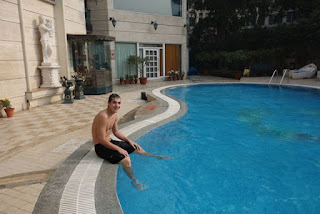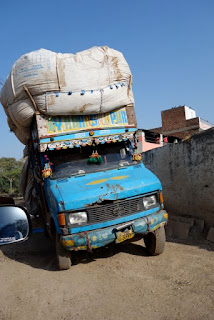Saturday, January 12th – Historical Deli
I wake hours before John and go downstairs to drink coffee and write this blog. I am graciously assured that it is “not a problem” if I drink my coffee now and return later with my son for breakfast. I sit and type and my waiter sees that my coffee cup is never empty.
I return to the room, collect John and at 8:30 we head downstairs for the buffet breakfast. The buffet is international and extensive, offering American cooked to order eggs and omelets, bacon and sausages, Korean noodles and spicy pots of vegetables, Indian curries, sushi rolls, fresh fruits, yogurts, cereals and an array of pastries and breads. In spite of the many options, I have seen this same spread at every 5 star restaurants between Egypt, Africa, China and now India. I choose fresh papaya, bacon and a potato lentil curry.
At 9:30 A.M. we are met by Navneet, who introduces us to our guide and driver for the day and quickly takes his leave. We drive in the direction of the Red Fort and Old Deli. Our guide has a heavy accent and is difficult to understand and does not know our itinerary? My printed itinerary is back at the hotel since I naturally assumed that our guide was briefed on today’s plan. He suggests various possibilities but I am frustrated since John and I do not know enough about Deli to make informed decisions.
 |
| Jama Masjid Mosque |
We begin with a visit to the Jama Masjid, India’s largest mosque, which accommodates up to 25,000 worshipers. The Mosque, built in 1656 and is constructed on a hill that rises above the old city. We climb a steep stone stairway up to the main gate, remove our shoes and deposit them with an ancient man, colorfully dressed and seated cross legged who will keep watch over our shoes for 10 rupees.
 |
| The Shoe Guardian at Jama Masjid Mosque
Naturally we wish to take photos within the immense courtyard and inside the mosque so we part with another 300 rupees each for our camera fees. The mosque is built of red sandstone, the courtyard framed on four sides by a promenade of columns and scalloped archways. The sandstone is intricately carved with Islamic symbols and white marble onion towers top and crown the edifices. John is fascinated by the architecture, the history and the experience. He asks our guide many questions, draws diagrams in his notebook and makes notes. John is disappointed that our guide’s answers seem taped and do not really address the questions that he has asked.
|
 |
| Courtyard – Jama Masjid Mosque |
 |
| Archway – Jama Masjid Mosque |
 |
| John taking Notes |
 |
| Arcade – Jama Masjid Mosque |
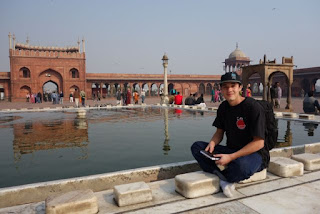 |
| Reflecting pool – Jama Masjid Mosque |
Our guide discourages us from wanting to visit the Red Fort and takes us instead to a 1000 year old Jain Temple down a side street. The façade doesn’t look like a temple but we climb up a few steps and enter through an open wooden door. Our guide hands us a printed sheet and we read the temple rules; no menstruating women may enter and no animal products are allowed inside. We take off our shoes, John removes his belt and I pass my leather purse to the attendant, seated cross legged on a raised platform with a ledger and pen poised. I take a calming breath and assure myself that my possessions and wealth will remain safe during this visit to the temple.
 |
| Painted Doorway beside Jain Temple |
 |
| Entrance to Jain Temple – Old City |
Barefoot, I climb ancient marble stairs feeling the stone chill beneath my feet. The temple is small but lovely and we peer into recessed mosaic shrines with smooth white marble figurines, honoring temple deity’s, each anointed with red smudges of color. After respectfully circulating the upstairs shrines, a temple attendant anoints our foreheads with a smudge of red, at the same time requesting a donation. I awkwardly pass him a 100 rupee note and we descend the cold marble stairs. My “purse guardian” is sitting vigil but when I go to claim my purse, he is firmly insistent that I make a donation to the temple. Apparently, the donation I made on the floor above was to the priest residing within the temple only.
 |
| John’s rickshaw ride – Old Deli |
 |
| Old City street scene |
We walk twisted alleys back to our two waiting tut-tuts and climb aboard. I ride solo in the first and John climbs into the tut-tut behind, alongside of our guide. We careen and jostle along crowded lanes clogged with humanity, cows, over-laden wagons and motorcycles.
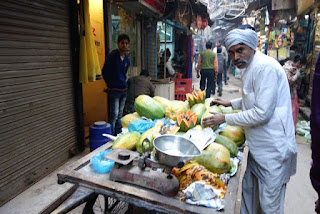 |
| Fruit Vender – Old City |
A political parade is marching along Chandni Chowk Street and the already crazy traffic is completely blocked. Music blares, people wave signs and a few floats move slowly on the opposite side of a barricade. Our tut-tuts cannot budge and after 20 minutes we get out and walk a kilometer to our waiting taxi.
 |
| Traffic Jam in the Old City |
 |
| Women pushing though crowds in the Old City |
 |
| Yesterdays Taxi Driver Friend |
We make a brief stop at the memorial to Mahatma Gandhi and listen to our guides spin on Gandhi’s life and his significance to India.
 |
| Memorial to Mahatma Gandhi |
Our guide suggests that we visit the Akshardham Temple, a temple with 20,000 carved deities. His English is hard to understand and it sounds impressive so we agree. What we didn’t grasp was that this is a new Hindu temple, completed in 2005. Because of terrorist bombings elsewhere in India, the temple is high security and we must leave purses, cameras, sim-cards and phones in the car with our driver. The grounds are not crowded today, but the temple is apparently packed on weekends and we cut through the line barricades that snake empty waiting for the weekend crowds. We pass through metal detector arch ways and at this point, men and women are separated and I am wanded and patted gently down behind a curtained area for women. The temple is immense, impressive and bewildering. Because of the unfathomable scale of this temple, I question if the sculptural facades might not be cast in plaster rather than carved out of salmon colored sandstone? Our guide insists that they are carved and I eventually concede but there are “clones” of the thousands of bas relief scultured elephants and deities frolicking along the façade of the temple. The interior of the temple is carved of white marble in giddying detail. All of the elements are in place for the making of a world wonder but I feel as if I am in Disneyland and am glad when we finally funnel through the immense gift shop, walk back along bridges crossing over pools with spewing fountains and traverse manicured garden pathways and back to our waiting car.
 |
| Purple and pink balloons at the Red Onion Restaurant in Deli |
We are starving and drive 40 minute though non-descript parts of Deli before stopping at the Red Onion Restaurant for a 3:00 P.M. lunch. The ceiling of this somewhat dingy, upstairs restaurant is decorated with pink and purple balloons and John and I are bewildered at the choice of this restaurant, lacking any Indian ambiance. In spite of the lack of promise, John and I remain in good humor and watch out the window as a workman on a 30 foot wooden ladder, held unsteadily by three men, repairs a tangle of overhead electrical wires. We pray for him, but also laugh and compare road and electrical repair work back in the U.S.A. and question the wasted man power of our system where two or three men are needed to simply hold caution signs. The chicken curry and broccoli dishes are surprisingly delicious and we forgive the bland atmosphere and the purple and pink balloons.
 |
| John and Marty – Qutb Minar |
 |
| Qutb Minar |
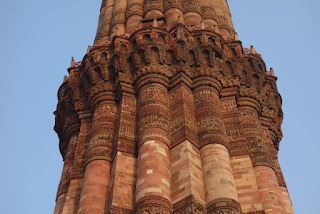 |
| Detail of Qutb Minar |
Refueled and revived we drive to Qutb Minar and the surrounding ruins of this 12th century victory tower. It is 4:00 P.M. and the late afternoon sun shines golden on this stunning architectural sight. The intricately carved, red sand stone minaret is 237 feet high and John is mesmerized and awed. His enthusiasm is catching and we simply want to be set free to explore but our guide drones on about the history in his difficult to understand English.
 |
| Column detail – Qutb Minar |
 |
| Bell column detail – Qutb Minar |
 |
| Minaret and Ruins – Qutb Minar |
Our impatience is obvious and our guide is insensitive to John’s energy and questions and continues to spout out well rehearsed data that we have little interest in. Eventually freed to explore, I follow John through arcades of intricately carved columns and through crumbling archways. I catch the fever of my 20 year old son’s enthusiasm and curiosity and I am joyful and present as we share these magical moments, exploring these ancient architectural wonders.
 |
| Visitors to Qutb Minar |
 |
| John exploring the ruins – Qutb Minar |
 |
| Qutb Minar |
The light is fading when we arrive at an overlook to the Bahai Lotus Temple, built in the shape of a blossoming Lotus Flower. It is nearly 6:00 P.M. and the temple is closed but our guide tells us this is the new “Taj Majal.” Even in the fading light, the temple is lovely and John makes a 5’ jump up onto a cement pillar, part of the fencing structure, wrapped in barbed wire. Our guide is taken by surprise which I am sure was partially John’s intention and John takes unobstructed photos of the Lotus Temple in the distance.
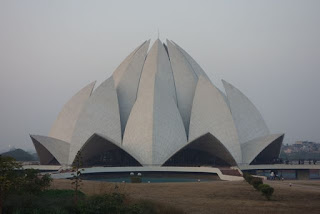 |
| Bahai Lotus Temple – New Deli India |
On our way back to the Royal Plaza Hotel, we make a stop at a the “market” which turns out to be a strip of “Government” owned tourist shops, each many levels high with dozens of lurking sales attendants. We exit 5 minutes later to look for our taxi and guide who have vanished under the assumption that we will certainly be inside and retained by pressuring sales attendants for a considerable time. We wander down the street and are invited into other multi level tourist shops with the enticing promise; “Just look, not have to buy.” I suspect that our guide is disappointed that we did not succumb to temptations within the shops since I have little doubt that the guides get commission from anything we might buy. We are dropped off at hotel and I tip both our driver and guide generously; but in retrospect, I rate the driver an A+ and the guide a C-.
After a few minutes in our room to refresh, John and I head out to find dinner but the directions we have been given by both our guide and the concierge are wrong. We walk briskly even though we have been told that this is a safe area to walk at night and there are many elegant hotels and guards promenading the tree lined sidewalk. A business man, obviously well to do and walking in the same direction as us, strikes up a conversation and informs us that the crafts market we are looking for has closed down due to construction. Construction barricades are directly ahead and he suggests that we go instead, to the Verda restaurant, off of Cognaught Circle. A lone tut- tut is parked at the curb on this darkened street and our new friend instructs the driver to take us to a night market, wait for us and then drive us to Verda restaurant. This will cost just 30 rupees, less than $1.
The market turns out to be another government shop but this time, the charming young man with a uni-brow, a fetching smile and good command of English, snares me. I see one tunic that I like and within seconds, he has unfolded and strewn dozens of others across the glass countertop. I know that he is asking too much for these monochromatic and minimally embroidered, “silk”, tunics and I try to bargain. He frowns at my low ball suggestion and the two caterpillars that form his eye-brows wiggle and he looks so crestfallen that I agree to the price of $14 each, hand over my credit card and we make our escape.
 |
| Verda Restaurant – Cognaught Circle |
Our tut tut driver is waiting loyally in front of the shop and drives us, seemingly in circles, to the Verda restaurant. The Cognaught Circle district is a series of concentric circular boulevards, cross-sectioned by other avenues and navigating the one way streets to the restaurant has its challenges. I am relieved we are not walking. A podium stands outside the entrance and we ask the attending woman if we may see a menu. It is expensive but the interior of the restaurant glitters invitingly and I do not have a backup plan. John and I are underdressed but we allow ourselves to be escorted to a table along the mirrored wall and I scoot into a quilted leather bench seat. John sits at the chair opposite me and we take in the ambiance of soft lighting reflecting off the mosaic ceiling. Venetian style glass chandeliers, lanterns and candles cast a warm light and lend a Bohemian charm to the bodacious décor. We are not all that familiar with Indian cuisine so John orders the tasting menu for about $25 and I order a single entrée of chicken curry for under $10. The service is impeccable and small plates begin to arrive at our table and we taste and share the various dishes. All is delicious but the cashew cauliflower is especially memorable and in we would have been filled and satisfied sharing only the tasting menu. In retrospect, I wish that I had taken notes on the various courses that we enjoyed so that John and I would have been better prepared for future meals in India. I enjoy drinking a glass of wine with my meals, but wine is not an affordable option in India so John and I share an Indian Kingfisher beer and relax into the magic of the evening.
